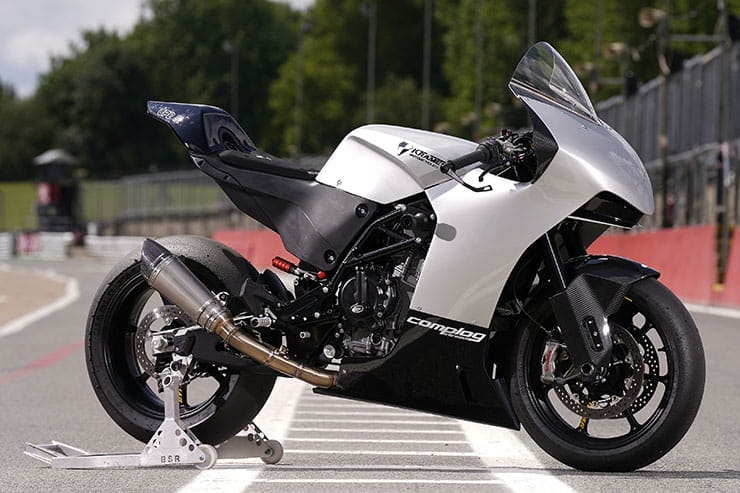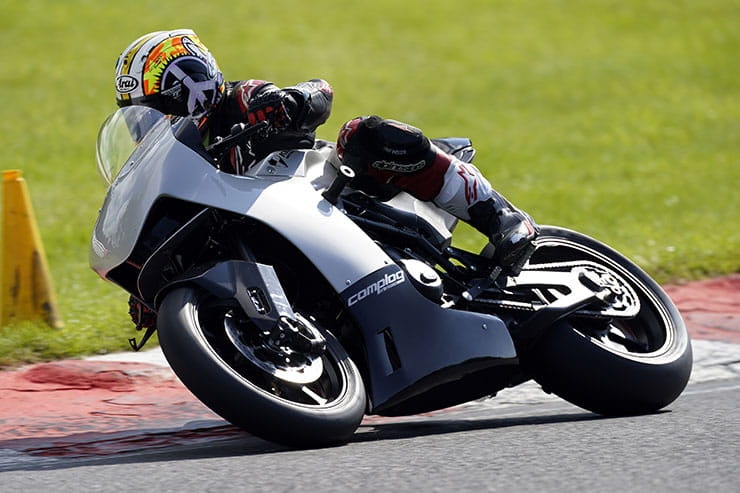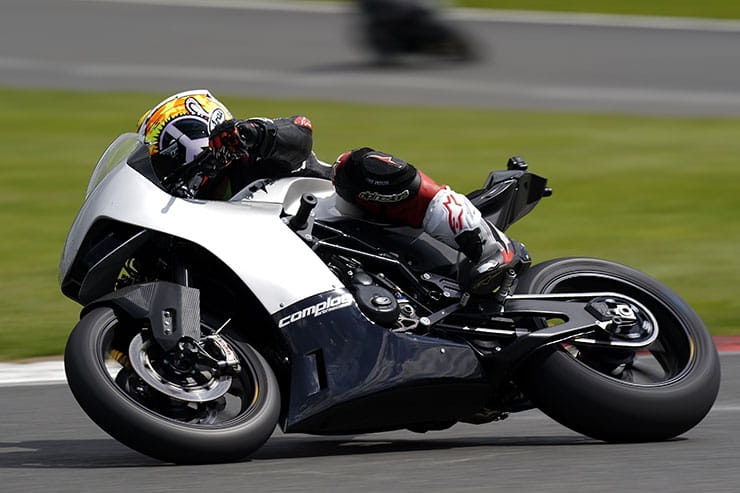Krämer GP2-R (2021) - Review
BikeSocial Road Tester
03.09.2021
Don’t worry if you have never heard of Krämer, most haven’t. The company was set up by former KTM employee Marcus Krämer, to build race bikes using KTM engines as their platform. This is not the first bike to come from Krämer, they already produce a single cylinder 690 EVO2-R, which weighs just 125kg and makes 85hp, as well as 790 twin, using the engine form the 2018 KTM Duke.
But this is the latest bike to come from the German factory: the bespoke GP2-R, and is equipped with the latest 890 unit which normally powers KTM’s 890 Duke R. And, yes, this is the sister bike to KTM’s £31,000 RC 8C, which was produced in limited numbers (100 were built) and sold out almost immediately. The RC 8C was built in partnership with Krämer – they are essentially the same bike aside from the different bodywork and wings. But unlike the KTM, you can buy a Krämer today for a more reasonable £26,480 – just paint it orange.
So what is it? Simply put, a ready-to-race track bike. It was never designed to be Euro-5 compliant or take luggage or a pillion; it was designed specifically for the track. This suggests the design team could focus directly on lap times and didn’t have to worry about comfort or mirrors.
This means it makes 130hp like KTM’s road bike but weighs just 140kg (dry). This is a very trick motorcycle: fuel tank under the seat, slick Pirelli rubber, lightweight Dymag wheels, WP fully adjustable suspension front and rear, multi adjustable chassis… Yes, seat height, rake angle and fork offset can all be adjusted. There’s also Brembo Stylema brake calipers, wet and dry engine maps, plus adjustable engine braking, an up and down quickshifter, a steering damper, serious crash protection, a brake guard, and a GPS dash/logger. Even the titanium bolts are pre-drilled and lock-wired.
The Krämer is a track-ready, over-the-counter race bike. Just turn up to a track day or race meeting, no trolly starter or pit crew required. The standard KTM engine starts on the button just like a road bike – but that is where the similarities end.
Race ready
Handling and feedback
Power, ease of use
Needs painting
Can’t be ridden on the road
You will want to got racing
What’s the new Krämer GP2-R race bike all about?
Adam ‘Chad’ Child and Michael Mann get chatty with the new £26k race bike as the subject. What is it and what’s it like to ride?
Krämer GP2-R (2021) Price
How much is the Krämer GP2-R? £26,480
Agreed, £26,000 is a lot of money for a bike you can only ride on the track. It is essentially a toy, like a high-end kit race car. But if you were to buy a road bike and convert it to a race bike, with a similar spec to the GP2-R and capable of (reliably) lapping a racetrack at the same time – then you’d need to spend between £20 and £30k on top of the cost of the doner bike.
From the box, the GP2-R is capable of lapping mid-pack in the highly competitive British Supersport Championship, against GP2 bikes, which are mainly expensive former Moto2 machines, and highly tuned road-based Supersport 600s.
This was proven in a ‘demonstration’ at the BSB meeting at Donington Park just a few weeks ago. A standard Krämer ran in the top 25 despite its standard KTM 890 twin, standard suspension setting and a rider who’d never sat on the bike previously.
Adapt the multi adjustable chassis, get the rider in-tune, and this is potentially a top 10 bike at national racing level, with a stock motor. Suddenly £26,000 seems to be a bit of a bargain.
Power and Torque
As mentioned, the engine comes directly from KTM, their 890 LC8c twin as used in the 890 Duke. With a different air-box and exhaust peak power is a quoted 130hp.
This may not seem like a huge number of horses, and it is down compared to highly tuned Supersport 600s (140bhp) or even Moto2-inpsired GP2s in BSB (130-140hp), but the Krämer is lighter, which gives it an impressive power to weight ratio. Torque is also notable, at 100Nm (73.76ftlb) output is more than a Moto2 or Superport bike.
Krämer could have tuned the engine, or chosen a different doner engine with more power, but they wanted to make the bike usable, cost effective, and not just for experts. But the KTM lump is standard and therefore should prove reliable. The gearbox and standard slipper clutch, too, are both standard – which reduces cost and keeps things simple.
Engine, gearbox and exhaust
Due to noise restrictions at Brands Hatch, we had to fit a noise-cancelling exhaust, which not only muffled the Krämer’s bark, but also strangled the power slightly. However, I was still impressed with the power. So too 23-time TT winner John McGuinness, who grabbed a few laps. “That’s quicker than I was expecting,” said a beaming John afterwards (see his full opinion a little further down).
During my first laps I was riding the Krämer incorrectly, treating it like a Supersport bike and using only the top 25% of the rev range. But that isn’t the way to ride the GP2-R. It is much more forgiving and easier to ride than highly stressed Yamaha R6 or Kawasaki ZX-6R. The key is to use the torque of the 890cc parallel twin; you don’t need to dance around on the oh-so smooth quick-shifter.
It doesn’t feel quick, but it is. You don’t need to rev it to red line, in fact you almost short shift through the gears. It feels controlled and manageable, reminiscent of a good Ducati 996, with usable torque low down and a lovely spread of power. It’s certainly a pleasing contrast to a screaming 600cc Supersport bike.
That usable power makes it easy to ride and unintimidating, yet still quick. With slick rubber onboard, you can apply the throttle super-early, giving the Krämer the jump on larger, more powerful bikes out of corners and feeling a bit like running a 100m race with a 50m head start.
There are two throttle maps to chose from, rain and road, which give full power but soften the fuel delivery. The don’t link to any electronic rider aids, because there aren’t any – more of that later.
Handling, suspension and weight
This is where Krämer have worked their magic. If you want to make the perfect cake, you need the right ingredients – and the Krämer kitchen is rammed to the rafters with the good stuff. To start with the GP2-R tops the scales at only 140kg. Then we have fully adjustable, high spec WP suspension front and rear. Add lightweight Dymag wheels, slick Pirelli Superbike rubber, Brembo Stylema brakes, Hyper Pro steering damper, lightweight racing chain – and you’re soon justifying the price tag. The fork offset is adjustable between 26 and 28mm, rake and trail, the seat height too, bar position, and obviously suspension. Everything is there to make the yummiest of cakes.
But if you’re intimidated by the prospect of tuning suspension, don’t be. We purposely rode the bike in standard trim, and it certainly delivers. I was unsure what to expect on a machine only slightly heavier than a road going 125, with huge slick rubber and the very latest suspension and brakes – but even on standard settings you have to recalibrate to what you can get away with.
The steering is incredibly light. Fast direction changes are effortless. But this isn’t a pocket size race bike with tiny clip-on bars; in fact, the ergonomics make the GP2-R user friendly, which allows you to point and throw the Krämer around with toy-like ease. On several occasions I turned in too early, hitting the apex sooner than I wanted. But once you’re dialled into the lightweight chassis – it’s incredibly dynamic. Fast direction changes are so easy and after 30 minutes on track you’re not out of breath like you would be on some bikes. Well, I might be anyway.
Mid-corner ground clearance worries are non-existent. The Krämer just wants you to let go of the brakes and carry maximum corner speed. There is so much grip and feedback you feel happy to feed the power back in on the apex and start to accelerate. You don’t need to push the bike up on to the fat section of the tyre wait and hit the power with fear – instead accelerate early, feeling the bike’s grip exploit the engine torque and start to overtake larger bikes. There’s an almost perfect balance of grip, feel and power for getting on the power early.
As mentioned, we wanted to run the bike in standard trim, and it impressed beyond all expectations. But, for my weight, I wanted to change the front a little, so I could carry even more lean angle – important around the short Brands Indy circuit. And although brilliant on the brakes running into the turn, I wanted a little more control on the fork rebound coming off the brakes. But I guess that is the beauty of the Krämer: it’s so easy to adapt and change, the perfect set-up for every rider and the conditions is just a click or two of the suspension away.
Comfort and economy
You don’t buy a race bike and overly worry about fuel consumption. However, the 890 KTM unit in road trim is frugal, and compared to rev happy 600cc bikes or thirsty litre bikes, the Krämer should be reasonable.
Interestingly the 16-litre fuel tank is under the seat, with the ¼-turn filler cap located just behind the rider on the lip of the tall racing seat unit. Having the fuel under the rider helps to improve the mass centralisation of the bike. Despite the fuel tank supporting the seat – it’s effectively the sub-frame – the seat height can still be increased for taller riders. A fuel drain plug at the bottom of the tank allows you to drain the fuel and measure the precise amount fuel for a track day or race (each litre of fuel is around 1kg and that translates into tenths, if you’re chasing that kind of time).
Despite being a narrow and lightweight bike the riding position is surprisingly roomy; this isn’t a Moto3-size bike built for midget racers. John McGuinness, who to be fair isn’t your average size racer, was impressed, and actually wanted to lower the bars and make the Krämer racier. I had no aches or pains after a full day at Brands Hatch – it’s surprisingly roomy with a decent and almost TT-like screen.
Brakes
With similar weight of a road going 125 and the same brakes as a 200kg superbike, plus changeable engine braking maps, excellent front forks and slick rubber, it’s safe to say the GP2-R stops!
One finger on the powerful, three-way adjustable Brembo lever is all that’s needed to haul up this lightweight race bike. You can change the feel, reach and travel of the track lever – personalise to your taste.
Again, if you are used to road bikes on track, it takes a little getting used to. You can brake later and let off the brakes earlier and carry immense corner speed. Plus, with so little weight, the Brembo Stylema stoppers aren’t over worked – therefore there is not fade. There’s no ABS, the Hel Performance braided lines run directly from the lever to the calliper.
The front discs are slightly smaller than you’d normally see on a sports bike: 290mm on the Krämer, compared to 320mm on, say, Yamaha’s R6, but the smaller discs save on weight. And bear in mind that the R6 is weighs in another 40-50kg on top of the Krämer.
Rider aids, extra equipment and accessories
Today it’s the norm for new bikes to be packed with multiple rider aids, launch control, lean sensitive traction control and braking, wheelie and rear wheel prevention. The list is almost endless. And the very latest rider aids on 1000cc-and-above sports bike machines are excellent, meaning it’s incredible what you can get away with. But those are road bikes, designed for the road, on road-based settings with around 200bhp.
The Krämer makes 130bhp, wears slick tyres and is designed to be ridden on track. So like most race bike of this size, riders aids are simply not needed. There are two engine maps, and two engine brake strategies and a track pit lane limiter – but that’s it.
You could argue some track day enthusiasts may want some traction control, especially for the wet. But with race wets fitted and the softer engine map deployed, I believe the majority of riders won’t miss the lack of electronic assistance.
As this is a pure track bike, there are no indicator buttons or horn. There’s simple-yet-beautifully pieced together racing switchgear to change the engine maps, engine braking and activate the pit lane limiter. The dash is a race Tacho AIM MXS 1.2 Race GPS with a built-in logger and GPS function which displays lap times and live information like sector times and best lap. Everything is recorded, meaning that back in the pits you can flick through your lap times with ease. Racers can delve further; look at speed, throttle position and mechanical temperatures.
Krämer have even thought about crash protection. There are spindle protectors, traditional frame crash bungs on the under-seat fuel tank and swingarm, but also neat little tricks like steering stops that are rubber mounted to stop the frame getting damaged when the bars are on full lock during a crash. There is even a small swing-arm protector plate behind the footrest, so the peg doesn’t damage the swingarm in a fall. While we’re talking footpegs, the plates which hold the pegs are identical both sides – therefore you only need to carry one as a spare.
Arguably you might need a spare set of wheels for racing, already wrapped in race wet rubber, but aside from that, it’s ready to race. There’s even a one touch rain light at the rear.
OPINION: John McGuinness
‘This is all track day riders need’
“I really enjoyed that. I didn’t think it would be as quick as it is, I was passing plenty of bikes. It doesn’t feel quick, but you can get on the power early. It’s roomy, you’re almost sat upright behind a decent fairing. If it was my bike, I’d want to be a little lower, with the bars more like a 250 race bike. The finish is lovely, with some really high-end components, and it feels quality, everything has been thought about. I was only going to do a few laps, but I just ended up enjoying myself. It’s light and easy to ride, not hard work. I see lots of track day customers struggling with powerful 1000cc bikes, when, to be fair, this is all they need. They’d have fun and lap quicker. I want to change a few bits, just set it up the way I want, then it would be a little flyer. Yeah, that’s impressive.”
Krämer GP2-R (2021) Verdict
The more time I spend with the Krämer GP2-R the more I appreciated its mechanical beauty and simplicity. The carbon front mudguard with Moto2-style details like a spoiler on the rear to help cool the radiator. The bike comes completely lock-wired, a neat little rain light, a pit lane limiter, even a brake lever guard. It’s ready to race - and an impressive package.
You don’t have to be an expert to ride the track-only GP2-R, though. it’s easy to manage, ultra-light with an unintimidating engine and lots of torque. The chassis allows you to make mistakes, yet an experienced racer can get onboard, dial in the multi-adjustable suspension and geometry, and run at the front.
Despite having relatively roomy ergonomics, it’s possible that if you’re a heavy rider or you ride fast, GP-layout tracks like Mugello, then maybe the Krämer isn’t for you. But for everyone else this a pure and compelling race bike and track toy. Despite running a stock 890 KTM engine, the GP2-R is capable of getting within a few seconds of a pole in a British Supersport race and is available directly to the customer.
KTM’s RC 8C, the sister bike to the GP2-R, sold out in under 30-minutes, and I can see why. The Krämer is the essentially the same bike, only not orange and cheaper. And yes, I want to race one…
Krämer GP2-R (2021) Technical Specification
Photos: Impact Images (Tim Keeton)
Video: Chris Newble
What is MCIA Secured?
MCIA Secured gives bike buyers the chance to see just how much work a manufacturer has put into making their new investment as resistant to theft as possible.
As we all know, the more security you use, the less chance there is of your bike being stolen. In fact, based on research by Bennetts, using a disc lock makes your machine three times less likely to be stolen, while heavy duty kit can make it less likely to be stolen than a car. For reviews of the best security products, click here.
MCIA Secured gives motorcycles a rating out of five stars, based on the following being fitted to a new bike as standard:
A steering lock that meets the UNECE 62 standard
An ignition immobiliser system
A vehicle marking system
An alarm system
A vehicle tracking system with subscription
The higher the star rating, the better the security, so always ask your dealer what rating your bike has, and compare it to other machines on your shortlist.


